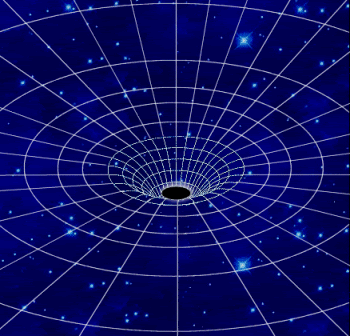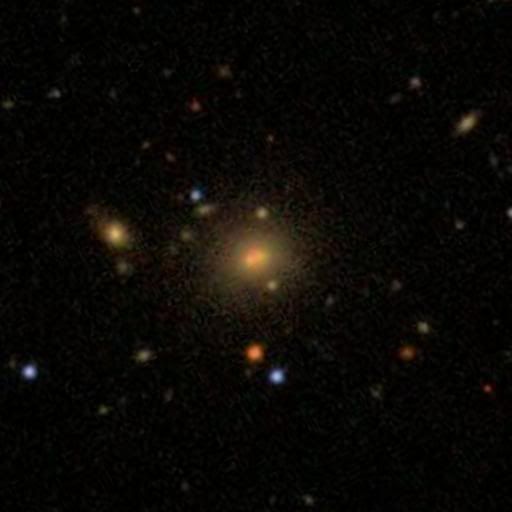Botanist lobbies to save humanity
... from miniature black holes that will devour the earth
Black Holes 101
A black hole is a point of infinite density where mass has been compressed to almost zero volume. This causes the fabric of spacetime to warp so severely that it essentially forms a hole in spacetime (there's lots of speculation about what's on the "other side" of the hole, but nobody knows). These holes are black, because they don't emit radiation*, which is why we can't see one directly. Your garden-variety black hole forms when the core of a massive star collapses. Physicists also think that much larger black holes were formed as a product of the big bang, and grew by colliding with each other and feeding on gas and stars to become supermassive black holes at the centers of galaxies. It takes an extreme event to form a black hole.

The event horizon of a black hole (also referred to as the Schwarzschild radius) is the gravitational point of no return. It's the distance from the black hole at which the escape velocity equals the speed of light. The escape velocity is precisely what it sounds like: how fast you have to go in order to escape the gravity of something. The escape velocity of the earth, for instance, is 11 km/s. The escape velocity at the event horizon of a black hole is 300,000 km/s. Once something crosses the event horizon, even light, it's toast. Forever lost from view. Flushed down the cosmic toilet, never to be seen again. The event horizon is effectively the size of the black hole.

Time for a thought experiment. Imagine that super-intelligent beings have come to the solar system and decided to experiment with the Sun by compressing it down to form a black hole. The laws of physics say that the size of the black hole scales directly with mass. A black hole with the mass of the Sun would be 3 km in radius (a little under 2 miles), which means you'd have to come within 3 km of the solar black hole to be "sucked in." This is something I emphasize with my astronomy students. If the Sun were suddenly replaced with a black hole of the same mass, the earth and all the other planets of the solar system would continue to orbit exactly as they always have. Except for the lack of sunlight, there would be no noticeable difference. The Sun is 300,000 times more massive than the earth. If these same intelligent beings decided to squash the earth into a black hole, its size would be 1 cm.
So, at the CERN laboratory, where careless scientists are on the verge of creating tiny black holes that will consume the earth, let's think about the possible consequences. We know that it takes extreme physics to create black holes, but let's assume CERN scientists are capable of this and imagine that they create a black hole with the mass of, say, an M1 Abrams tank (60 tons). The size of such a black hole would be 2 x 10-20 cm. That's 0.00000000000000000002 cm. Something would have to get that close to the M1 Abrams black hole to be "sucked in" by it. But let's be realistic. These scientists are experimenting with much smaller masses -- sub-atomic particles, to be precise. A proton, for example, has a much smaller mass than the tank, 1.7 x 10-24 g. A trillion-trillionth of a gram. The size of a proton-mass black hole is so miniscule, it's not even worth contemplating. It's much smaller than the Planck length, the smallest size anything can be, so essentially a proton-mass black hole can't exist.
But there's another wrinkle to this. Black holes gradually evaporate through a process called "Hawking radiation," which has to do with quantum effects near the event horizon of the black hole. According to physics, the lifetime of a black hole is proportional to its mass to the third power. The M1 Abrams black hole would last about 0.6 seconds before it evaporated away. The lifetime of the proton-mass black hole (which theoretically can't exist) is much shorter than the Planck time (5 x 10-44 seconds), the smallest measurable increment of time. In other words, it would evaporate before we even knew it existed.
Conclusion: Miniature black holes are not a threat to humanity.
[* In theory, black holes can emit a small amount of radiation, the aforementioned Hawking radiation. So far this has not been directly observed.]
[Lightly edited to clarify sizes of micro black holes.]
A colourful American botanist, teacher, former biologist and sometime physicist says (in outline) that the LHC may rip a hole in the fabric of the space-time continuum and so destroy the Earth. He wants the US government to act now and delay the LHC's startup while a new safety review is carried out.The article is hilarious, but it's evident this "sometime physicist" doesn't understand physics very well. In fact, this touches on a subject a lot of laypeople misunderstand: Do we need to worry about miniature black holes? Read on and find out!
Walter L Wagner and his fellow Hawaiian Luis Sancho, according to a report on MSNBC, filed suit in the Hawaii federal court last Friday. The men are worried about one of several planet-busting physicists' nightmares being unleashed in the LHC's bowels deep beneath the Franco-Swiss countryside. (According to Wagner's website, as of publication, the LHC is located "near Generva, Switzerland".)
Firstly Wagner is concerned that careless atom boffins might slip up and create a miniature black hole. This would then suck in surrounding mass, gaining unstoppably in size and power in a runaway process until it had engulfed the entire Earth and packed it down inside its swelling, unescapable event horizon.
Black Holes 101
A black hole is a point of infinite density where mass has been compressed to almost zero volume. This causes the fabric of spacetime to warp so severely that it essentially forms a hole in spacetime (there's lots of speculation about what's on the "other side" of the hole, but nobody knows). These holes are black, because they don't emit radiation*, which is why we can't see one directly. Your garden-variety black hole forms when the core of a massive star collapses. Physicists also think that much larger black holes were formed as a product of the big bang, and grew by colliding with each other and feeding on gas and stars to become supermassive black holes at the centers of galaxies. It takes an extreme event to form a black hole.

The event horizon of a black hole (also referred to as the Schwarzschild radius) is the gravitational point of no return. It's the distance from the black hole at which the escape velocity equals the speed of light. The escape velocity is precisely what it sounds like: how fast you have to go in order to escape the gravity of something. The escape velocity of the earth, for instance, is 11 km/s. The escape velocity at the event horizon of a black hole is 300,000 km/s. Once something crosses the event horizon, even light, it's toast. Forever lost from view. Flushed down the cosmic toilet, never to be seen again. The event horizon is effectively the size of the black hole.

Time for a thought experiment. Imagine that super-intelligent beings have come to the solar system and decided to experiment with the Sun by compressing it down to form a black hole. The laws of physics say that the size of the black hole scales directly with mass. A black hole with the mass of the Sun would be 3 km in radius (a little under 2 miles), which means you'd have to come within 3 km of the solar black hole to be "sucked in." This is something I emphasize with my astronomy students. If the Sun were suddenly replaced with a black hole of the same mass, the earth and all the other planets of the solar system would continue to orbit exactly as they always have. Except for the lack of sunlight, there would be no noticeable difference. The Sun is 300,000 times more massive than the earth. If these same intelligent beings decided to squash the earth into a black hole, its size would be 1 cm.
So, at the CERN laboratory, where careless scientists are on the verge of creating tiny black holes that will consume the earth, let's think about the possible consequences. We know that it takes extreme physics to create black holes, but let's assume CERN scientists are capable of this and imagine that they create a black hole with the mass of, say, an M1 Abrams tank (60 tons). The size of such a black hole would be 2 x 10-20 cm. That's 0.00000000000000000002 cm. Something would have to get that close to the M1 Abrams black hole to be "sucked in" by it. But let's be realistic. These scientists are experimenting with much smaller masses -- sub-atomic particles, to be precise. A proton, for example, has a much smaller mass than the tank, 1.7 x 10-24 g. A trillion-trillionth of a gram. The size of a proton-mass black hole is so miniscule, it's not even worth contemplating. It's much smaller than the Planck length, the smallest size anything can be, so essentially a proton-mass black hole can't exist.
But there's another wrinkle to this. Black holes gradually evaporate through a process called "Hawking radiation," which has to do with quantum effects near the event horizon of the black hole. According to physics, the lifetime of a black hole is proportional to its mass to the third power. The M1 Abrams black hole would last about 0.6 seconds before it evaporated away. The lifetime of the proton-mass black hole (which theoretically can't exist) is much shorter than the Planck time (5 x 10-44 seconds), the smallest measurable increment of time. In other words, it would evaporate before we even knew it existed.
Conclusion: Miniature black holes are not a threat to humanity.
[* In theory, black holes can emit a small amount of radiation, the aforementioned Hawking radiation. So far this has not been directly observed.]
[Lightly edited to clarify sizes of micro black holes.]








